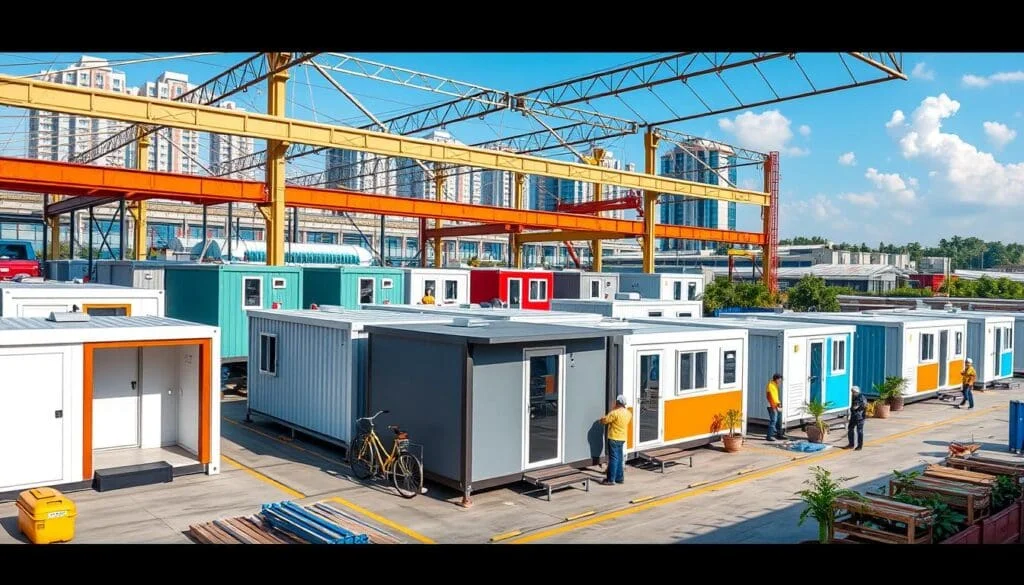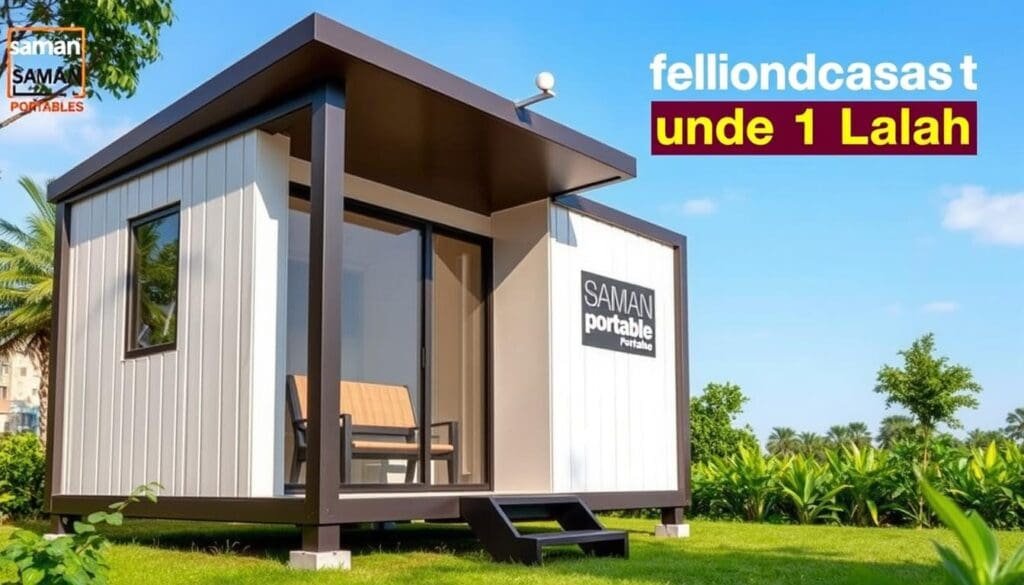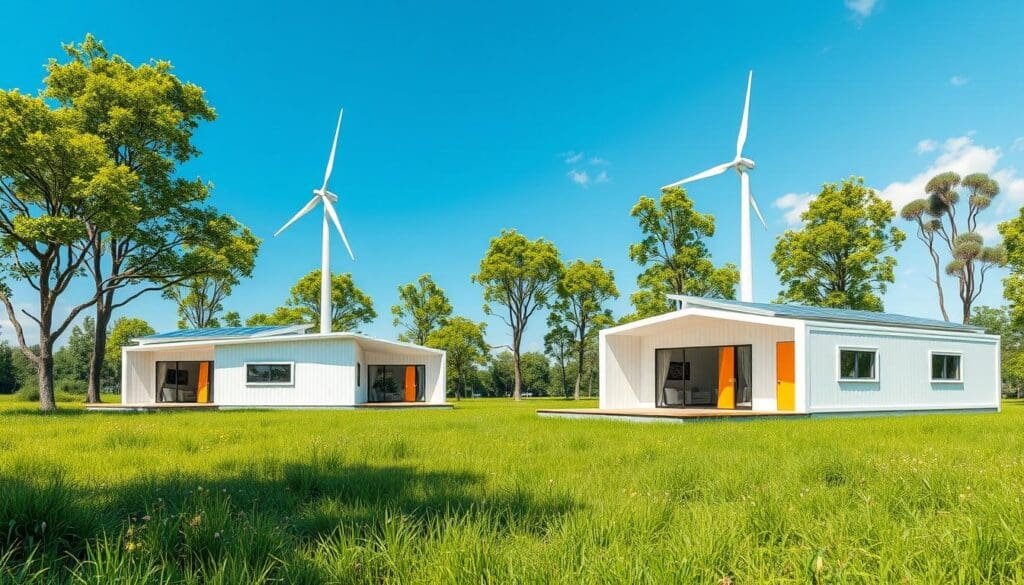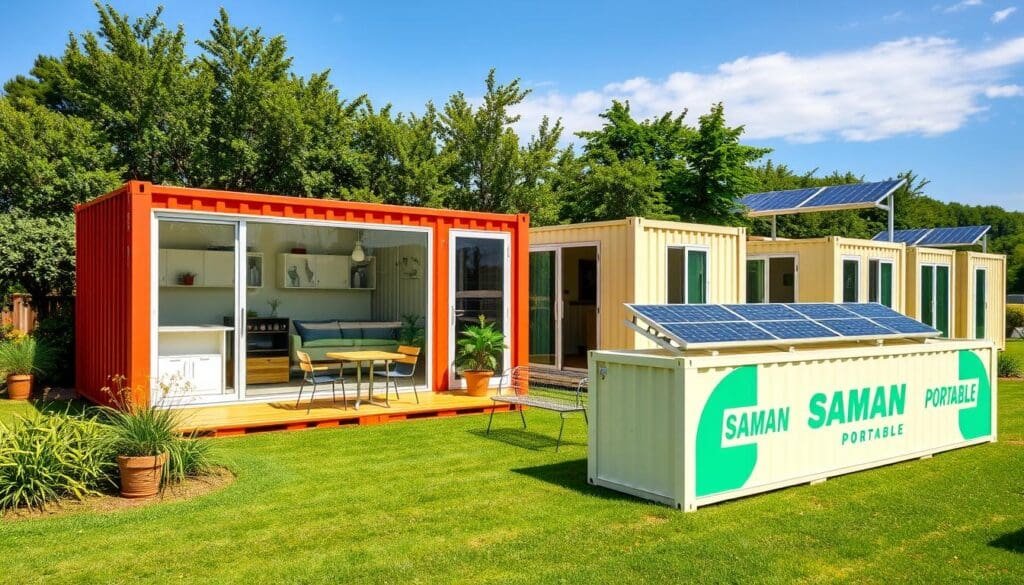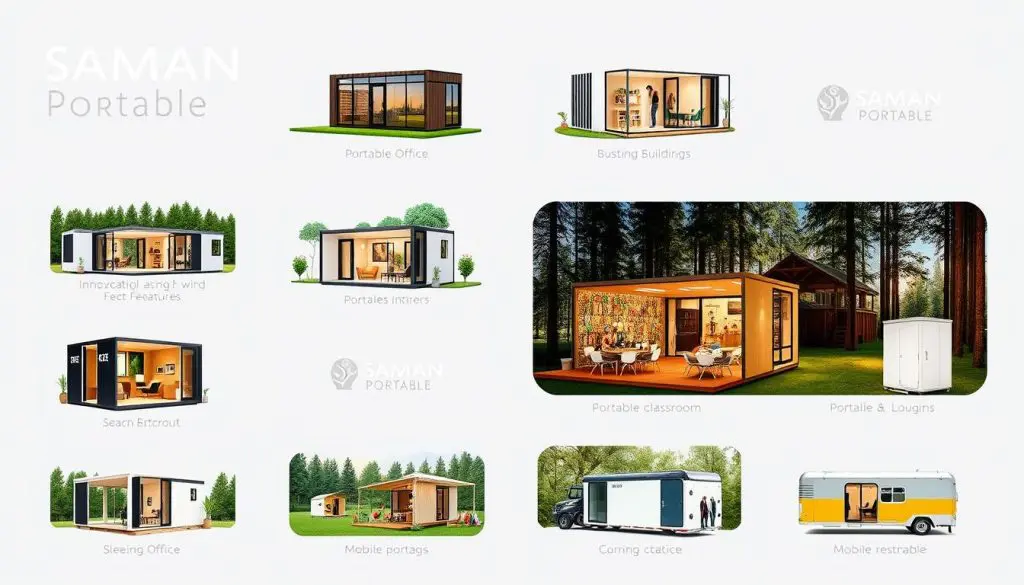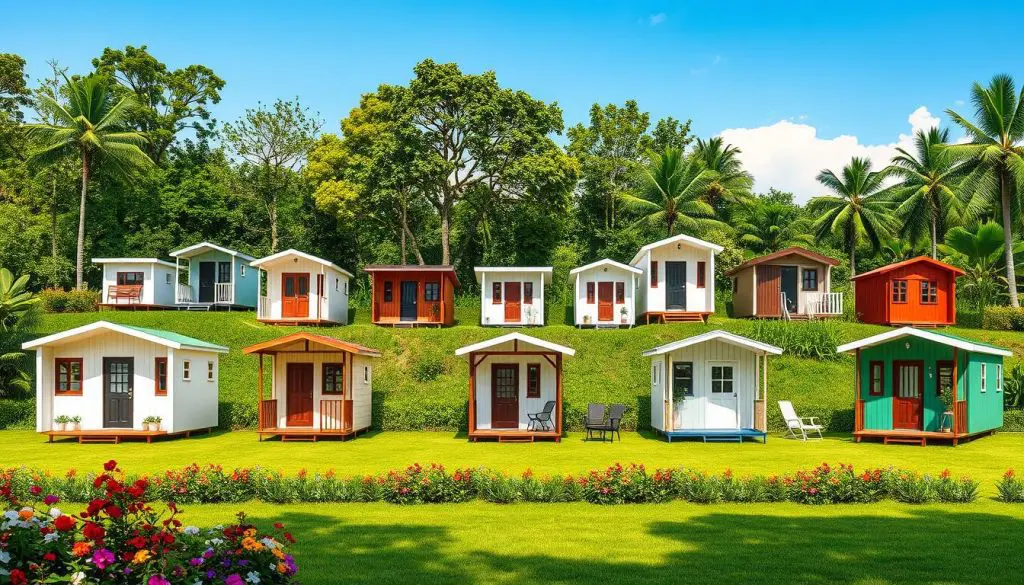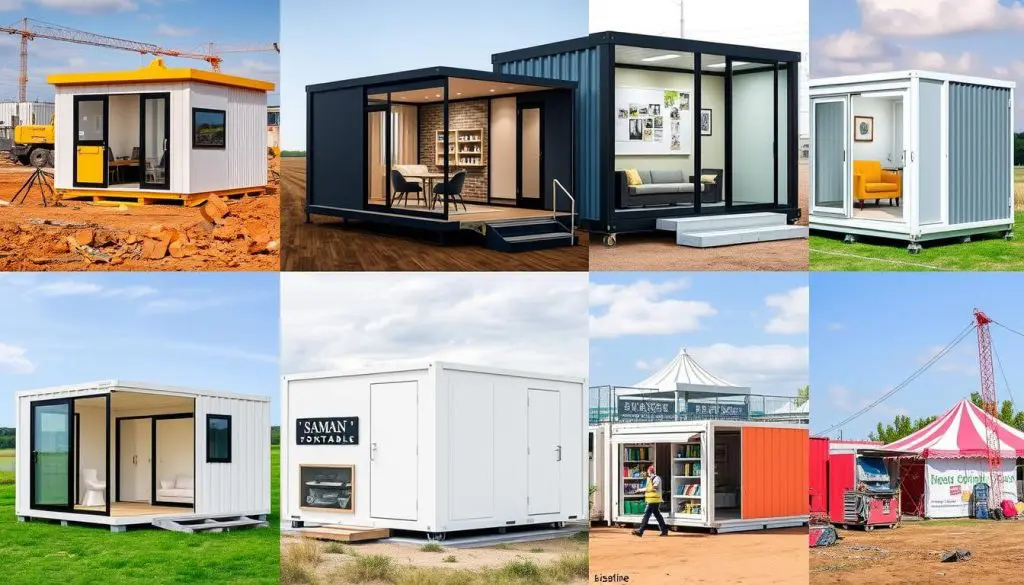Top Portable Building Manufacturers: Quality Prefab Structures Tailored to Your Needs
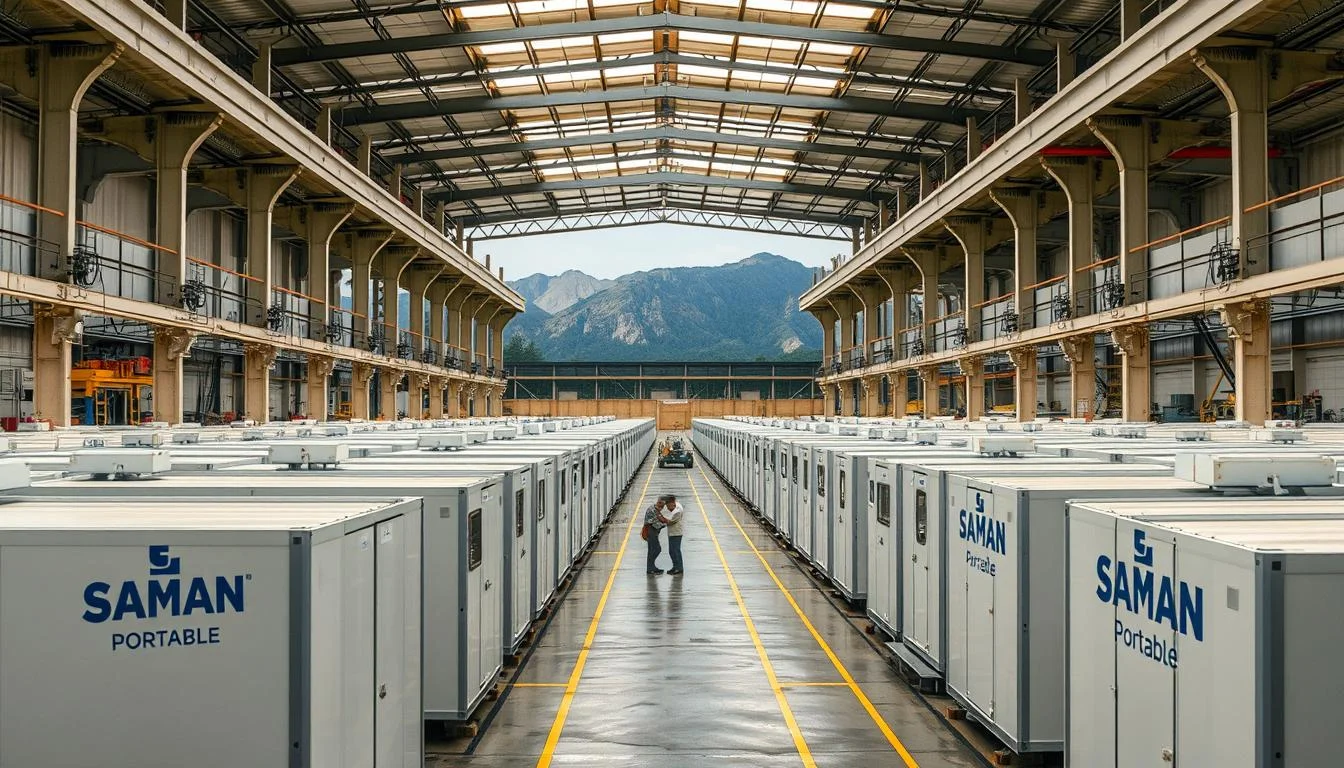
Are you tired of traditional construction methods? They often waste time, resources, and slow down your project. What if there was a new way to build that could make your project faster and cheaper?
In India, portable building makers are changing construction with new prefabricated solutions. These pre-built buildings are super flexible for temporary needs in many industries. Companies like Pressmach Infrastructure and Multi Decor India lead in making construction faster.
Today’s portable building solutions are a big step forward in design. They use factory production to make buildings that are more than just structures. They are key assets for businesses wanting quick setup and top quality.
Key Takeaways
- Prefabricated structures reduce construction timelines dramatically
- Advanced manufacturing ensures superior quality control
- Portable buildings offer cost-effective solutions across industries
- Customization options meet diverse project requirements
- Sustainable and environmentally conscious construction methods
Understanding Prefabricated Building Solutions
Prefabricated building solutions are changing the way we build. They offer a new way to make structures like portable car sheds and temporary garages. This method is more efficient and precise.
Construction has changed a lot. It’s now done in factories instead of on-site. This makes buildings more precise and of higher quality, all in less time.
Evolution of Modern Construction Methods
Prefabricated solutions have brought big benefits to construction. Some key changes include:
- Standardized manufacturing processes
- Enhanced precision in component creation
- Reduced on-site construction timelines
- Improved quality control mechanisms
Benefits of Factory-Based Production
Building in factories has many advantages. For example:
- Material waste reduction (10-30% less than traditional methods)
- Labor cost savings of 20-50%
- Faster assembly times
- Consistent product quality
Quality Control Standards
Quality control is very important in prefabricated manufacturing. Special facilities use skilled inspectors. They check every step to make sure the structures meet high standards.
About 90% of the prefabrication process happens in these controlled settings. This ensures the products are reliable and perform well.
Leading Portable Building Manufacturers in India

India’s portable building industry has grown fast. It now offers new solutions for temporary needs. This includes garage shelters, mobile buildings, and storage sheds.
Indian manufacturers have made big strides in technology and cost. They provide a wide range of options. This goes from small storage sheds to large industrial buildings.
- SAMAN Prefab: A leading name with impressive achievements
- Completed over 65,000 buildings nationwide
- Delivered about 1,500 PEB projects
- Built India’s fastest factory in just 150 hours
- Crystal Cabins: Offers top-quality portable structures
- 85% customer response rate
- Focuses on modular portable solutions
- HR Corporation Pvt. Ltd: Provides innovative prefab solutions
- 79% customer satisfaction rate
- Uses advanced portable building technologies
The Indian prefabricated building market offers big savings. Pre-engineered buildings (PEBs) are 20-30% cheaper than traditional methods. They also save 30-40% on construction time, perfect for businesses needing quick solutions.
Pricing for these structures varies a lot. You can find options from ₹250/sq ft for steel prefabricated structures to ₹2,000/sq ft for steel modular portable shops. This means businesses can find solutions that fit their budget and needs.
Innovative Technologies in Prefab Construction
The prefab construction world is seeing a big change thanks to new tech. Now, making temporary garages and portable cabins is more precise and efficient. This change is making building faster and better.
Today’s prefab construction uses the latest tech for top-notch buildings. Digital design tools and automation have made making modular buildings much better.
Advanced Manufacturing Processes
New ways of making things are leading prefab construction into the future. Some key tech advancements include:
- Robotic automation for exact parts making
- 3D printing for complex parts
- Computer-controlled making systems
- Precision engineering
Digital Design Integration
Digital tools have changed prefab construction design. Building Information Modeling (BIM) helps with:
- Better views of garage and cabin designs
- Teamwork between designers
- Customizing cabins easily
- Virtual testing
Automation and Precision Engineering
Automation is key for quality and less mistakes. Precision engineering lets makers create complex prefab parts with great accuracy. This meets strict building standards.
These new techs are pushing prefab construction toward greener, more efficient, and flexible buildings.
Sustainable Practices in Prefab Manufacturing

The prefabricated construction industry is changing how we build. It’s turning cost-saving container office spaces and premium porta cabins into green solutions. These solutions help reduce our impact on the environment.
Key sustainable strategies in prefab manufacturing include:
- Reducing construction waste by up to 90%
- Minimizing carbon footprint through efficient production methods
- Utilizing recycled and energy-efficient materials
- Implementing precision manufacturing techniques
In India, construction waste is a big problem. It generates about 150 million tonnes of waste every year. Only 1% of construction waste is currently recycled. This makes sustainable prefab practices even more vital.
Modern prefab manufacturers use advanced technologies. They create cost-saving container office spaces that help the environment. These premium porta cabins have:
- Enhanced insulation systems
- Reduced material consumption
- Energy-efficient design principles
- Minimal on-site construction disruption
By following circular economy principles, prefab manufacturers do more than build structures. They create sustainable infrastructure solutions for India’s environmental challenges.
Cost-Effectiveness of Prefabricated Structures
Prefabricated structures are changing the game in construction. They offer big savings for businesses and organizations. Traditional building methods often have high costs, but prefab is more affordable and efficient.
Prefab structures save money in many ways. They are great for all sorts of projects, from worker camps to trendy cafes.
Initial Investment Considerations
Looking at construction costs, prefab stands out:
- On-site labor costs can drop by up to 50%
- Less material waste thanks to precise making
- Projects finish faster, meaning quicker use
- More predictable budgets with fewer surprises
Long-term Financial Benefits
Prefab also saves money over time:
- They use less energy, cutting down on costs
- Need less upkeep
- Last longer than regular buildings
- Can be changed easily later
Maintenance Cost Analysis
Prefab buildings are very durable. They need much less maintenance than usual buildings. This is because they’re made in a controlled factory setting, ensuring better quality and fewer repairs.
Companies choosing prefab can save a lot of money. This is true for special projects like worker camps or unique cafes.
Applications Across Various Industries

Portable building manufacturers have changed the game in many industries. They offer pre-built buildings that are quick and easy to set up. This is perfect for businesses that need fast, flexible workspaces. Industrial temporary buildings are also key for companies needing to grow quickly.
Different sectors use these structures in their own ways:
- Construction Industry: Uses porta cabins for offices, homes for workers, and safe storage
- Healthcare Sector: Sets up mobile clinics and disaster relief units in hard-to-reach places
- Education: Adds classrooms and special learning areas
- Retail and Hospitality: Opens pop-up stores, food stalls, and temporary service centers
These structures really shine in tough times. During the COVID-19 pandemic, they became testing sites and places for vaccines. At the Aero India Show in Bengaluru, they helped with tickets and gave people a place to rest.
The benefits of portable buildings are clear:
- They can be set up fast, in about 15 days
- Save up to 30% on labor costs
- Reduce waste by 20-30%
- Can be customized up to 75%
Innovative portable building makers are changing India’s infrastructure. They offer solutions that are scalable, efficient, and fit many different needs.
Customization Options and Design Flexibility
Modern portable buildings offer a wide range of design choices. Whether you need a small car shed or a large temporary shed, there are many options available. This flexibility helps meet the needs of different clients.
Prefabricated structures have changed how we design spaces. They allow businesses and individuals to create unique areas that fit their specific needs. Up to 60% of portable building owners can customize their structures to match their vision.
Architectural Possibilities
The designs for portable buildings are impressive. You can find everything from sleek car garages to complex modular setups. Thanks to advanced technology, these structures are truly exceptional.
- Rapid design adaptation using digital modeling
- Scalable architectural configurations
- Aesthetic versatility matching traditional construction
Interior Configuration Choices
Modern portable buildings offer great interior design flexibility. With a 75% customization rate, users can design spaces that meet their needs perfectly.
- Modular room partitioning
- Flexible electrical and plumbing configurations
- Integrated smart technology options
Modular Expansion Capabilities
One exciting feature of modern portable structures is their ability to grow. Businesses can expand their facilities easily, making future changes simple.
Portable buildings are also cost-effective, saving 30-50% compared to traditional construction. They can be set up in just 1-3 hours, making them a quick and efficient solution.
Quality Materials and Construction Standards
Modern prefabricated structures are a top achievement in engineering. They are key in making temporary garage shelters and mobile buildings. These solutions use the latest materials and strict building standards, setting new industry highs.
Creating high-quality temporary storage sheds involves several important steps:
- Advanced material selection
- Precision manufacturing techniques
- Comprehensive quality control processes
- Adherence to international building codes
Manufacturers have changed the game in portable building production. They follow strict quality standards. Pre-engineered buildings (PEBs) are 30-40% lighter than old structures but are very durable. They go through tough tests to make sure they can handle extreme weather.
Modern prefabricated solutions show their strength in several ways:
- Energy efficiency boosts up to 30%
- Maintenance costs drop by 20-30%
- They can stand up to harsh weather
- They offer custom design choices
Quality goes beyond just picking materials. Today, makers use new tech like thermal insulation and smart designs. This makes temporary storage sheds perform better than ever. With about 90% of steel being recyclable, these buildings are also good for the environment.
Installation and Assembly Process
Prefabricated structures like temporary garages and portable cabins are changing construction. They make building faster and simpler, saving businesses a lot of time and effort.
The setup for prefab structures is quick and precise. Most of the work is done in a factory, ensuring top quality and less disruption on-site.
Site Preparation Requirements
Getting ready for installation is key. Important steps include:
- Checking if the ground is level
- Deciding on the foundation or support
- Planning for utility connections
- Ensuring easy access for delivery trucks
Professional Installation Services
Teams of experts are trained for fast setup of portable cabins. They focus on:
- Placing parts exactly right
- Using strong fastening methods
- Doing thorough quality checks
- Finishing quickly
Timeline Expectations
Prefab structures are fast. A temporary garage can be set up in 2-3 weeks, unlike months for traditional builds. This means big savings and quicker start-ups.
The modular way cuts down on mistakes and delays. It gives businesses a dependable and efficient building option that fits many needs.
Weather Resistance and Durability Features
Cost-saving container office spaces and premium porta cabins are top-notch solutions for harsh weather. They use the latest in engineering and materials to last a long time.
These portable buildings stand strong against all kinds of weather. They have features like:
- Wind resistance up to 150 km/h
- Design life exceeding 50 years with proper maintenance
- Robust weatherproof membrane protection
- Advanced reinforcement techniques
Modern prefab structures use the latest tech to be very durable. They use materials that don’t rot and special engineering to be strong. Even in tough weather, prefab steel buildings stay over 90% strong.
These durable options save money too. Companies can save up to 50% compared to building the old way. Plus, they use less energy, saving up to 50% on energy costs.
By focusing on the best materials and making them with care, these solutions offer great protection and reliability. They are perfect for businesses that need flexible and strong infrastructure.
After-Sales Support and Warranty Coverage
Buying prefabricated structures means you need strong after-sales support. This support is key for keeping your buildings safe for years. It’s vital for both labor colonies and container cafes.
Our warranty plans give you peace of mind. They offer great protection. Here’s what you get:
- Extensive structural warranty up to 20 years
- Coverage for leakage and water-related damages
- Comprehensive maintenance support
- Rapid response technical assistance
Our buildings last over 50 years with the right care. Regular maintenance and inspections keep them in top shape. This means your investment lasts longer.
Here’s how to make a warranty claim:
- Submit detailed documentation
- Provide original purchase records
- Verify serial number
- Receive prompt evaluation
We don’t stop after setting up your buildings. We fix issues fast, usually in five business days. We also offer advance replacement to keep your operations running smoothly.
Our support team is always ready to help. They solve problems quickly. This keeps your buildings running well for years.
Future Trends in Portable Building Manufacturing
The world of portable building manufacturing is changing fast. Companies are coming up with new ideas that will change the construction world. As the market grows, so do the types of buildings we can make.
The market for modular and portable buildings is expected to grow a lot. It’s predicted to reach $130.2 Billion by 2032. This shows how much people want buildings that are flexible and good for the planet.
Emerging Technologies
New technologies are leading the way in portable building making:
- AI-driven design optimization
- Advanced robotics in production processes
- Smart building integration systems
- Enhanced digital modeling techniques
Market Predictions
There are big changes coming in the portable building world:
- Projected CAGR of 2.93% from 2024 to 2032
- More people want these buildings for homes
- Everyone wants to build in a way that’s good for the planet
- More temporary buildings will be needed
Innovation Roadmap
Portable building makers are working on a few key areas:
- Sustainability: Using recycled stuff and cutting down on carbon
- Energy Efficiency: Making buildings that use less energy
- Rapid Deployment: Building faster, up to 50% quicker
- Adaptability: Making buildings that can be used in many ways
The future of portable building making is full of exciting changes. These changes will change how we think about and use buildings in many fields.
Conclusion
Portable building manufacturers have changed how we build in India. They offer pre-built buildings that are flexible and efficient. These industrial temporary buildings are a smart choice for businesses looking for flexible infrastructure.
They can be set up quickly and designed to fit any need. This makes them great for many different industries.
Statistics show the power of portable buildings. They can cut labor costs and reduce waste by 20-30%. Companies can start using them in days, helping them grow fast and meet changing needs.
These buildings also save a lot on energy costs, up to 40%. This makes them a smart choice for businesses looking to save money. The market is growing, showing more companies see the value in these buildings.
In India’s growth, portable building makers are leading the way. They focus on making buildings that are custom, fast, and affordable. This is changing how businesses and industries build in a fast-changing world.
FAQ
What are the key advantages of prefabricated buildings?
Prefabricated buildings save time and improve quality. They also reduce waste and are cost-effective. These structures are flexible and can be quickly set up to meet various needs.
How do portable building manufacturers ensure quality and durability?
Top manufacturers focus on quality control. They use advanced engineering and automated production. They test thoroughly and use high-grade materials to ensure durability.
Can prefabricated buildings be customized for specific industry needs?
Yes, they can. Modern manufacturers offer many customization options. You can change the layout, materials, and design to fit your needs in healthcare, education, and more.
What is the typical lifespan of a prefabricated structure?
With good care, they can last 50 years. Durability depends on materials, environment, and maintenance. Many offer warranties and support for long-term use.
How sustainable are prefabricated buildings?
They are very sustainable. They produce less waste and have lower carbon emissions. Many use eco-friendly materials and follow circular economy principles.
What is the installation process for portable buildings?
The installation is quick and done by professionals. It involves site prep, assembly, and setup. This process is faster than traditional construction, with less disruption.
Are prefabricated buildings suitable for different climate conditions?
Yes, they are designed to handle various weather conditions. They use weatherproofing technologies like insulation and reinforced designs. This makes them durable in extreme weather.
How cost-effective are portable buildings compared to traditional construction?
They are more cost-effective. They have lower initial costs, reduced labor, and faster construction. This makes them a budget-friendly option for businesses.
 Container Cafe
Container Cafe



















































































